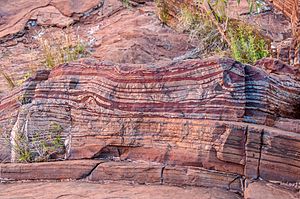
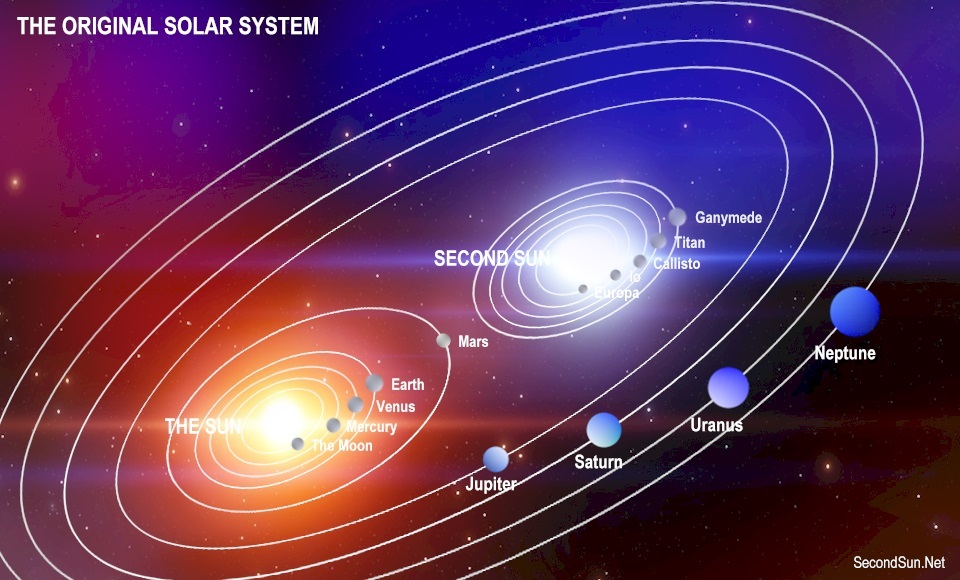
| The Second Sun |
A study shows that there was a second sun (star) in the solar system used to orbit in the asteroid belt, between Mars and Jupiter, around 200 million years ago.
Published: January 15, 2014
Last Updated: September 10, 2019
|
|
The full report in a single page |
|
|
The report by parts (toc, overview, etc. in separate pages) |
 |
Scroll down
|
![]()

The dominant theory suggests static electricity in clouds. Experiments have shown that this theory is incorrect — Charged particles originate from volcanoes on Jupiter's moon Io...

Last Updated: July 2, 2025
The second sun and the existing sun used to orbit in the solar system around a common center of mass, like all other binary star systems elsewhere in space.
It ended its life cycle as an active star about 200 million years ago (mya). When that happened, it started producing metals and chemicals, including the compound hydrogen and oxygen (H2O) in the form of water vapor. The water vapor got frozen in space as ice asteroids and then fell on Earth, creating oceans. All the earth's metals have come from the second sun, plus the basalt rocks that make up the seafloor, and are in the building structure of fold mountains. As a result of the added material, all the planets in the solar system have expanded, Earth, Mars, etc.
| It started orbiting the existing sun after losing the most of its mass |
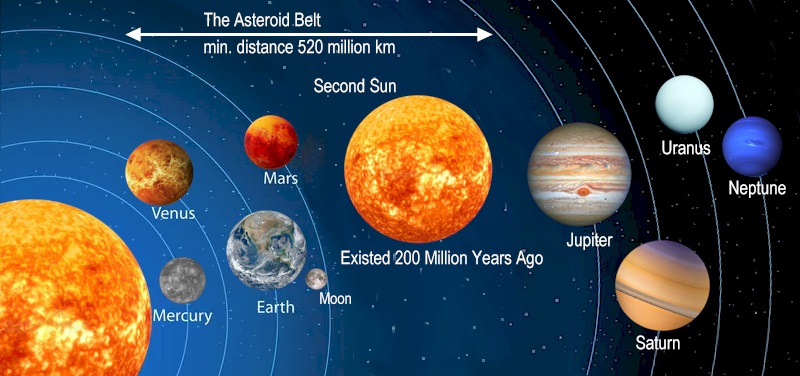 |
| The asteroid belt is a sign of a second sun |
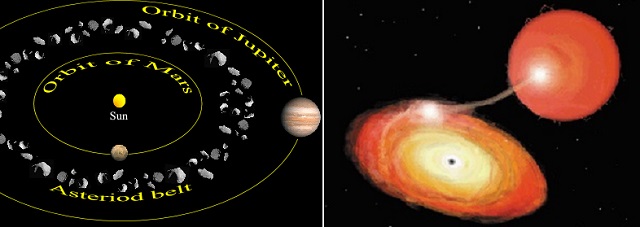 |
|
Space observations
have shown that the source of
debris disks
is a companion dying star. So if there were no companion star (second sun) in the solar system, the asteroid belt wouldn't have existed.
It is true that the asteroid belt doesn't look exactly the same as the new disks that are currently forming, the reason is that it is a very old disk, lost at least 99% of the material it initially had. The common assumption is that the asteroid belt is a leftover material from the formation of the solar system, based on the idea of the Nebular theory, but is this theory correct? NASA Mission Suggests Sun and Planets Constructed Differently |
| Why is Mars smaller than Earth? |
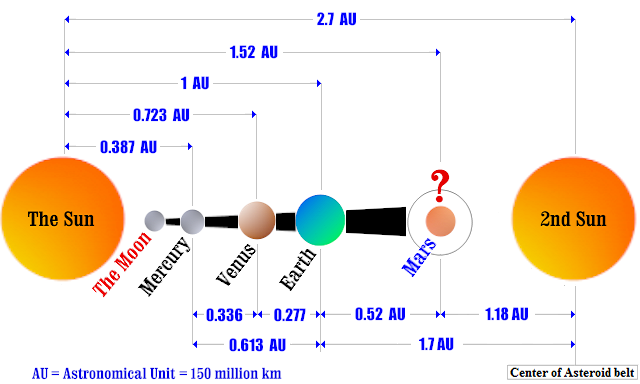 |
| Based on the arrangement of the inner planets,
we see that the closer the inner planet to the Sun, the smaller it is; and the farther the bigger.
Mars is the farthest inner planet from the Sun, so it should be bigger than Earth, but it is smaller,
it is about half the size of Earth.
It is the second sun that prevented Mars from having the size that is supposed to have. The moon was originally the first planet next to the sun! |
| The Gas Planets |
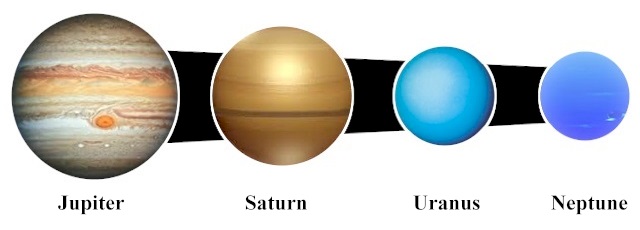 |
| Unlike the inner planets, the sizes of the gas planets are in reverse order:
the planet that is closer to the Sun, the bigger it is; not just bigger, but too
much bigger! Jupiter has a mass of about 317 the mass of Earth. The Great Red
Spot itself is so big that three Earths would fit in it easily. Saturn's mass is
about 95 the mass of Earth.
Gases from the dying second sun attracted to gas planets and increased their mass and gas volume. |
| Heat Transfer |
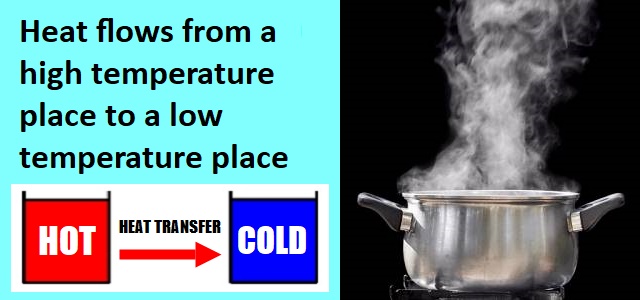 |
| What happens if you boil water on
fire? You see the water vapor goes
to the ceiling; and if the ceiling is divided into two parts, one part is cold
and the other is hot, you will see most of the water vapor goes to the cold part. The
second law of thermodynamics explains this process as follows: heat flows
spontaneously from a hot to a cold body.
The second sun, by the end of its life, failed to burn fuel and convert it to light; so where do you think the hot fuel will go? To the cold body! And that is exactly what happened. Some of the remaining fuel, rust and dust were attracted to the inner planets due to gravity, but the most have gone to the cold bodies, Jupiter and Saturn, so their size and mass increased greatly; Uranus and Neptune were not affected that much because they are very far away from the asteroid belt, the final orbit of the second sun. |
| Jupiter was the smallest gas planet, Neptune was the biggest. |
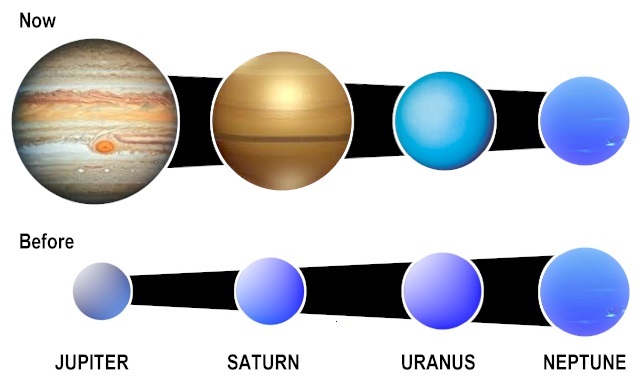 |
| The planet that is closer to the sun must be smaller, because of the heat and other radiations from the sun, even if it is a gas planet, unless an extra mass or volume was added to the planet at a late time to make it bigger than it should be. |
| Size and Mass of Planets | ||||||||||||||||||||||||||||||||||||
|
Uranus is bigger than Neptune in diameter (4.01 > 3.88), but smaller in mass (14.5 < 17.1). It is not following the size and mass sequence of the gas planets (bigger diameter and bigger mass). Something abnormal must have taken place in the planet's history that altered its size or mass.
The size and mass mismatch of Uranus shows that the original composition of the planet has been changed. The direction of change started from Jupiter toward the outside of the solar system, otherwise the diameter of Neptune would have been bigger. By following the direction of change we see that Uranus was originally smaller than Neptune, Saturn was smaller than Uranus, and Jupiter was the smallest gas planet, as shown in the picture above.
Heavy gases and solid materials accumulated in planets closer to the source, whereas light gases traveled farther. When the light gases reached Uranus, they were attracted by the planet. They enlarged the planet's size, but didn't affect its mass that much.
| The sun's brightness increased |
 |
|
A great amount of the matter from the second sun must have fallen into the sun due to its
immense gravity. The sun's size and mass increased.
The mass transfer is observable with the current technologies. Theoretically, it gives the other star more energy, and therefore brightness (luminosity). The matter from the companion star is distributed between all the objects in the system, depending on the object's gravity and place, whether it is a hot or a cold place, near or distant. The sun is the most massive object in the solar system, with the strongest gravitational pull, so it must have taken most of the matter. The attracted matter was reused by the sun, specifically hydrogen and helium. As a result, the sun became a more powerful star. |
| The moon was the first planet next to the sun |
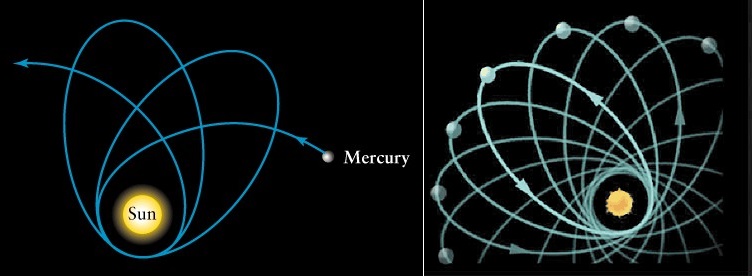 |
|
The orbit of Mercury is the most irregular orbit of the planets in the solar system. This strange orbit is attributed to the sun's gravitational pull on the planet. While Einstein's Theory of General Relativity explained the orbit of Mercury greatly, small discrepancies have been observed between the actual orbit and calculation: Correcting Einstein's calculation of the orbit of Mercury The small discrepancies found in Einstein's calculation could be corrected by the moon if it is placed somewhere between Mercury and the Sun, in the position where it used to be. The moon has all the features needed to be classified as a planet; it has a spherical shape, lowlands, highlands and a mantle. It used to have volcanoes, which means it had gases inside its mantle. Since it is the smallest "planet," then it has be the first from the sun.  The atmosphere of the moon is almost of a zero thickness, just like the atmosphere of Mercury. The solar wind is the only known factor to burn the atmosphere of planets. So the moon must have been in a position very close to the sun in order for solar wind from the sun to destroy its atmosphere. |
| Planets of the second sun: currently moons of Jupiter and Saturn |
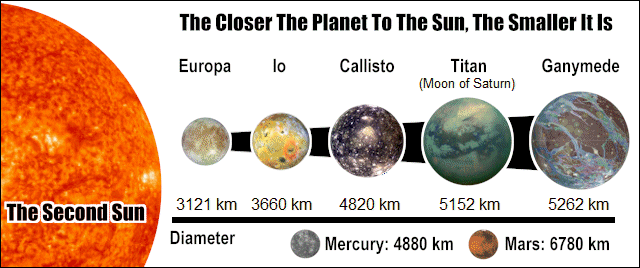 |
 |
The total number of planet-like moons in the solar system is six, the Earth's moon is one of them, the other five used to be planets of the second sun, four of them are orbiting Jupiter now (Europa, Io, Callisto, Ganymede), and one moon is orbiting Saturn, the moon Titan.
The moon of Jupiter Io has over 400 "active" volcanoes, it is the most volcanically active space object in the solar system.
These moons have spherical shape, mountains, lowlands, highlands and a mantle; what else do they need to be classified as planets? To orbit a star? That is the only thing they are missing now.
| The solar system might have been in this layout when the second sun was fully functioning, in a binary star system, each sun has five planets. |
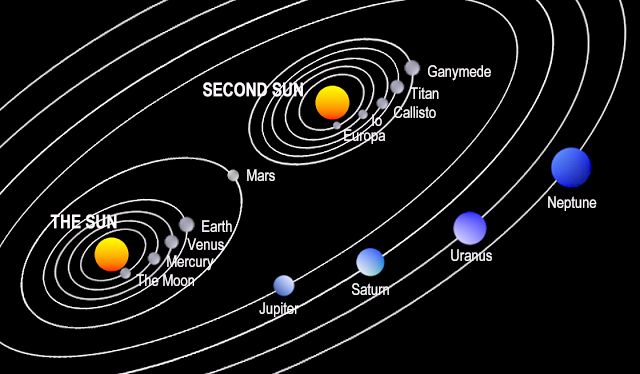
|
| Why is Mars Red? |
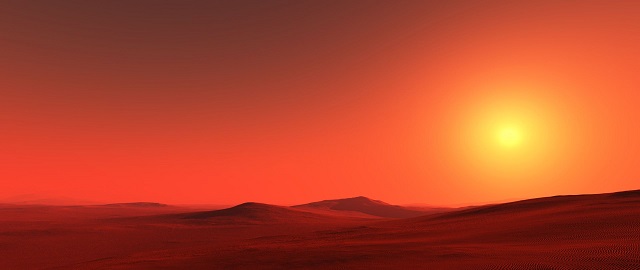 |
| Because the surface of Mars is rich in iron oxide (rust). Iron oxide is a product of dying stars. |
| Dying Star Iron (Fe) |
 |
| The last element produced by dying stars is iron (Fe), and then this iron is combined with H2O water vapor, which is also produced by the dying star. H2O makes the iron to rust. This kind of rust can be found on Earth now in many deserts around the world. |
| Percentage of rust on the surface of the inner planets |
 |
|
The percentage of rust on the surface of the inner planets is not well studied, so the numbers shown in the figure above are approximate. Generally the inner planet that is closer to the asteroid belt, the more percentage of rust it has on its surface, and as we move away from Mars toward Mercury, the amount of rust decreases. This shows that the source of rust was very close to Mars; it is from the other side between Mars and Jupiter. 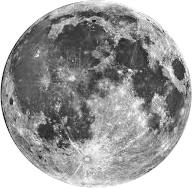 The moon also has iron oxide! How is it possible for the rust to form on the moon without water? The rust on the moon is not caused by oxygen traveling from Earth to the moon, as assumed, but it was "deposited" on the surface of the moon readymade from factory, 200 mya, which is also the case for all other planets. |
| Solar wind destroyed the atmosphere of Mars |
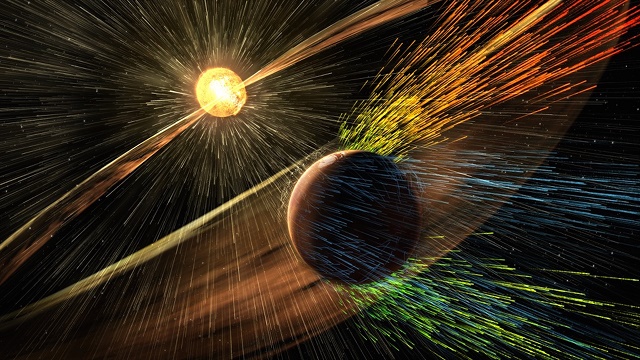 |
| The atmosphere
of Mars is less than 1% of Earth's. The solar wind of the second sun destroyed the
atmosphere of Mars, just like what the solar wind of the existing sun has
done to the atmosphere of Mercury and that of the moon when the moon was the
first planet next to the sun.
The common belief is that solar wind from the existing sun is the one that destroyed the atmosphere of Mars, on the the assumption that the early sun had a stronger solar wind. A recent study has shown that the effect of the solar wind from the sun on Mar's atmosphere is negligible, even if the early sun had a stronger solar wind: Mars' atmosphere well protected from the solar wind So there must have been another solar wind, from another sun, very close to Mars, and very strong, burned the planet's atmosphere from top to bottom. |
| The earth had no metal at all before 200 million years, not even inside the earths' internal layers. | |||
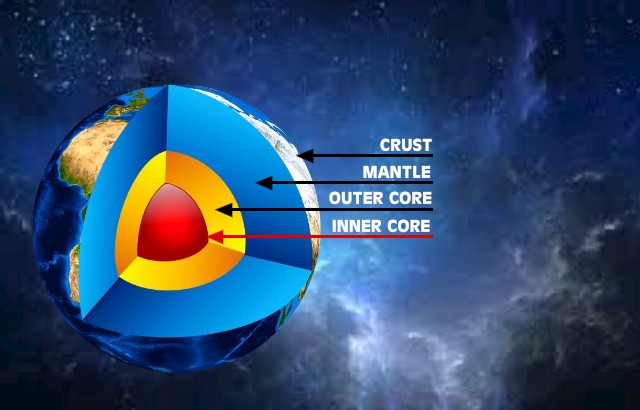 |
|||
|
The earth inner core, that is thought to be made of iron and nickel, isn't as old as
the earth itself, but it is an added part at a very
late time, and it is getting bigger. Some scientists give it an age of
about
500 million years only, compared to the Earth estimated age of
about 4 billion years.
At the end of life of the second sun, the generated gamma rays in the nuclear reactions of the star were not converted to light or any other form of energy, but have gone out of the star direct, hitting all nearby objects. These powerful rays have hit the earth and the other inner planets directly. They interacted with, and ionized gases inside the earth's internal layers. The gases expanded, the earth's crust opened up in some places to release pressure. Rocks from the second sun have fallen from the sky and entered the earths' internal layers from the open areas. The rocks melted and released their metal. The released metal concentrated in the center of the earth and started forming the inner core. The melted rocks are still releasing metal now, so the inner core of Earth is getting bigger. 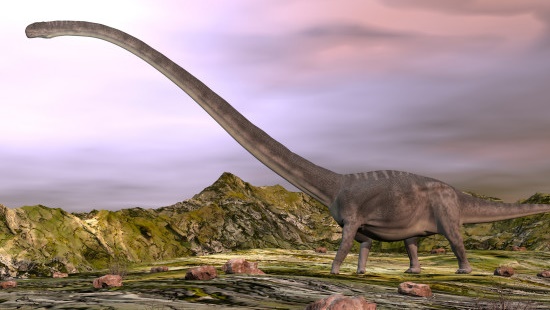
200 million years ago the earth's gravity was very low, because the inner core was very small. If the dinosaurs weren't very large animals, their life on a low gravity Earth could have been impossible, and if it happens for the dinosaurs to come back to life again, they wouldn't be able to walk on the earth today, unless their size is decreased. It is thought that dying stars do not produce solid materials, rocks and metal asteroids, but observations of dying stars elsewhere in space have shown rocks and metals orbiting dying stars. These solid materials are products of the dying stars themselves, and not of nearby destroyed planets, as assumed. Not all stars are the same. Some maybe destroying planets, but not all. The second sun in its final days became like a nuclear reactor creating chemical atoms. It created all kinds of chemical elements, including hydrogen and oxygen. These two elements combined to form H2O water vapor. This water vapor became frozen in space, some of which was attracted to the inner planets due to gravity, and then fell on them as ice asteroids. Most of it has gone to the gas planets. On Earth, these ice asteroids created oceans. There were no oceans on Earth before 200 million years. The idea of a single large body of water surrounding a supercontinent is theoretical without any supporting physical evidence; no part of a seafloor of the supposed large ocean has been found anywhere on Earth. 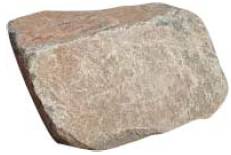 Some other chemical elements combined together and created rocks that are now making the the seafloor, and are in the building structure of fold mountains, and then these rocks have fallen on Earth and the other inner planets. These basalt rocks are the same as the basalt rocks that are found in the asteroid belt, which indicates that their origin is not Earth, but the sky.

Ionized gases create a magnetic field Magnetic Field
 The high-pressure gases that opened up the Earth's crust were initially ionized by gamma rays from the second sun. Ionized gases (plasma) create a magnetic field. The magnetic field created by large volumes of ionized gases can extend to outside the Earth's atmosphere into space. Since basalt rocks are rich in iron and magnesium, they were attracted by the magnetic field generated by the ionized gases in the open areas in the Earth's crust; the same is true for the open areas in the other planets. The rocks fell in the open areas, where the magnetic field is high, more than in the areas where the crust remained intact. The rocks melted in the mantle and were recycled to form the ocean floor on Earth and the lowlands on the other planets. The Earth's atmosphere must have been different at that time than it is today, so it didn't burn the falling rocks as it burns meteorites today. 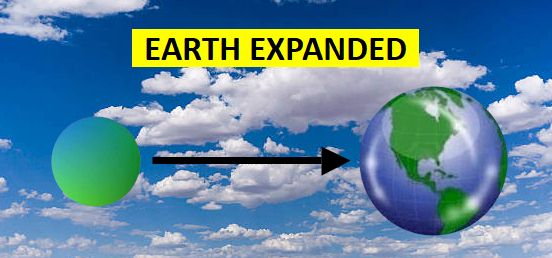 As a result of the added material, Earth has expanded. The Earth expanded once only, and not continuously expanding as suggested by The Expanding Earth Theory. Ocean tides cause tectonic activity and continental drift
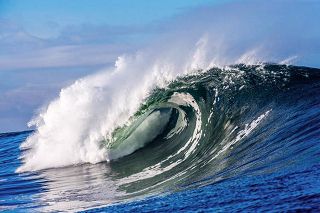 Lava flow - magma equivalent
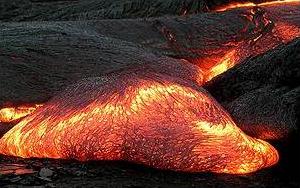 When a large volume of water moves, the hot magma (molten rock) inside the earth's interior also moves. The movement of water and magma causes the seafloor to be recycled in one place, in an ocean trench, and produced in another place, from an ocean ridge. This leads the ocean floor to shrink in one place, and expand in another. So if there is no rise and fall of sea level (no movement of water), there will not be any magma movement, and therefore there will not be any tectonic activity and continental drift at all. Why is the continental crust not destroyed and recycled like the oceanic crust, expanding in one place and shrinking in another, with trenches like in the ocean? Not because it is thicker, but simply because it is in a stable state. No alternating forces are applied on it. Sometimes heavy traffic cause ground shaking, because it is a force leads the land crust to an unstable state. If the traffic is in the magnitude of ocean tides, the landmass will definitely shrink in one place and expand in another, just like the seafloor.
Continental drift started 200 mya only,
because there were no oceans before that time.
Mars Expanded
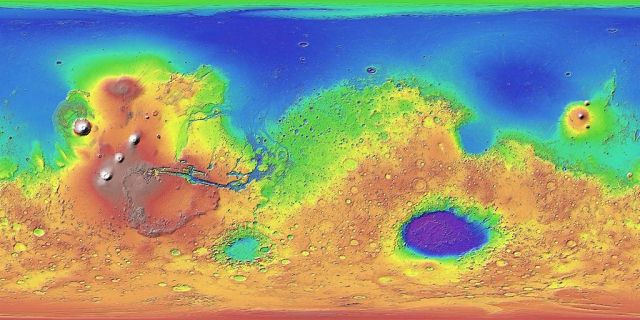 Not just the Earth, the other inner planets have also expanded. The lowlands (blue) on the other planets, which are equivalent to the ocean floor on Earth, are added parts. All lowlands, in all planets, are younger in age than the highlands. Mars Lowlands Younger than the Highlands — According to the crater counting technique, the surface of a planet with less craters must be younger than the surface on the same planet with more craters. Mars lowland is much smoother than the highland, with very few craters, which shows that Mars has expanded; not "resurfaced", as assumed. The moon's lowlands

Venus' lowlands were also "resurfaced", in addition to the moon's and Mercury's lowlands. The hypothesis Major Resurfacing Event is just a suggestion without any supporting evidence whatsoever. It does not explain how this global surface formation can happen in a short geological time or the force behind it. Volcanism is thought of as a possible mechanism, but the number of volcanic craters on the formed areas isn't many to produce lava flows that cover all of these areas. The planets have expanded. All of these lowlands are new, not resurfaced, added to the planets at a late time, in the same way the ocean floor was added to Earth, and all of them are no older than 200 million years, just like the ocean floor on Earth.
Because the earth's gravity was very low 200 mya, the rocks were falling on each other but not breaking. The rocky outcrops in the picture above were originally basalt, but due to weathering and the soil they were buried in, they lost their properties. The way they were deposited is very much similar to those of Mars, which indicates that the two planets received the rocks they have in the same manner.
Most of the frozen waters deposited on Mars, in the form of ice asteroids, have melted, and then evaporated to space, because of the thin atmosphere of the planet, but Earth preserved the received water. The water covered the whole planet Earth. Traces of this water can be found now all over the Earth's landmass, but the assumption is that the traces are of ancient oceans. There is no difference between the assumed ancient oceans on Earth and those that have supposedly existed on Mars in ancient times. The traces of water in these two planets are not of real oceans, but of a large volume of water has fallen as ice asteroids from the sky, melted, stayed temporary in some areas, and then shifted place gradually over millions of years, but on Mars, it has evaporated to space, because of the thin atmosphere of the planet, it is less than 1% of the Earth's atmosphere. Banded Iron Formations (BIFs) are layers of iron in sedimentary rock (sandstone), supposedly formed in ancient seas, but they are not forming today in the existing seas! They can be found now in many sandstone mountains around the world. BIFs are thought to have formed in sea water at a depth of 200 meters. If the water covered the earth's landmass to a depth of 200 meters, where was the seafloor? It is a lowland, the water is supposed to sit there. As mentioned earlier, there was no seafloor at that time, it has just started to form. It took the earth millions of years to settle at the shape and size that it has now. The billions of years that is being thrown as a radiometric dating of BIFs cannot be correct. BIFs are subjected to contamination from Earth's elements. |
| Mercury and the Moon: Similarities and Differences |
 |
|
Mercury's surface is gray and heavily cratered. It is very similar to the surface of the moon. This indicates that both bodies share a history of violent collisions with asteroids and comets, suggesting that both formed under similar harsh conditions, and lived in these conditions for a very long time. The main difference between Mercury and the moon is that Mercury is much denser than the moon. While Mercury's size is just 1.4 times the size of the moon, it has a mass of about 4.5 times greater than the Moon's. This led to the conclusion that Mercury has a large metallic core. The explanation for this heavy metal core is that one or more metal asteroids from the second sun have fallen inside Mercury's mantle. The asteroids initially were attracted by the sun's gravity. While they were moving toward the sun, they collided with Mercury. They fell into the open area in Mercury's crust, going all the way to the mantle. Melted inside the mantle and formed the large metal core. The evidence to support this idea is that another asteroid, believed to be metal, impacted the moon. The impact crater is about 2,500 km in diameter. The asteroid is now buried under the lunar surface, on the far side, within the South Pole-Aitken basin, the largest impact crater on the moon. If this metal asteroid landed on the surface of the moon, the assumption is that a similar asteroid landed on its neighbour, Mercury, but inside the mantle. This huge asteroid impact on the moon could be the one that kicked the moon out of its orbit around the sun, to finally settle into an orbit around Earth. 
In addition, the sun currently has a very large amount of iron. It is about 0.14% the mass of the sun. This figure may sound very small, but it is 1.4 times the mass of Jupiter, 330 times the mass of Earth. If Earth didn't have any metal until very recently, neither inside its mantle, nor on its surface, would the sun, Mercury, or the other planets have any initially? All of this iron and other heavy elements were added to the sun at a late time. The immense gravity of the sun pulled most of the remains of the second sun. A few iron asteroids landed in the mantle of Mercury. The Giant Impact is the dominant hypothesis for the formation of the moon. It suggests that a Mars-sized body impacted the early Earth, creating a debris disk around Earth, and the moon then formed from this disk. The hypothesis was initially formulated in the 19th century. When some rocks were brought from the moon in the 60s, some of those who adopted the hypothesis decided to analyze isotopes from the rocks. The isotopes were checked and found similar to Earth's isotopes. If the isotopes are similar, it suggests that the two celestial bodies may have formed from similar materials or under similar conditions. However, the isotopes were found to be dissimilar when they were analyzed recently: New Study Shows the Earth and Moon are not so Similar After All. The study has revealed that the Moon has higher oxygen isotope values, suggesting a distinct origin or history for the materials that formed the Moon. The isotopes were used as the only factors to prove the hypothesis. The Mars-sized body, the collision, and the debris disk are all imaginary. The isotopes test has proven the hypothesis scientifically invalid. |
| The Permian - Triassic Extinction Event |
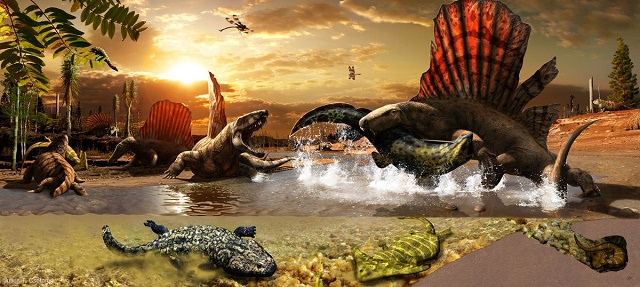 |
"It was almost the perfect crime. Some perpetrator -- or perpetrators --
committed murder on a scale unequaled in the history of the world. They left
few clues to their identity, and they buried all the evidence under layers
and layers of earth. The case has gone unsolved for years -- 250 million
years, that is."
(science.nasa.gov)
This mass extinction was caused by the dying second sun, it took the Earth 30 million years to recover. The long lasting period of the extinction shows that the cause was present all of this time. |
| Volcanism all over the Earth |
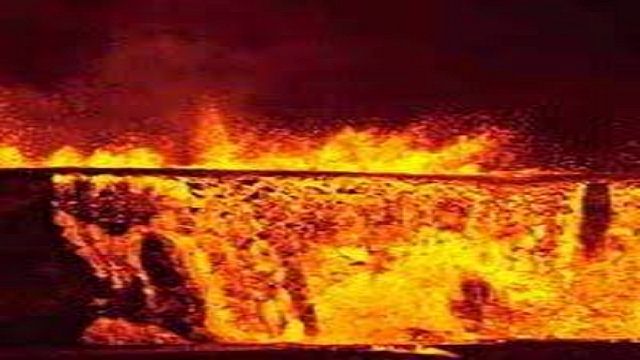 |
|
QUOTE: "The Earth was engulfed in widespread volcanism at the time of
the extinction" Volcanism wasn't the only event to happen during the extinction 200 mya, but other major events have also taken place in the same time: mountains were rising, the ocean floor was forming, the continents started to drift, and the earth was taking a completely different shape, so how to explain all of this happening simultaneously? There must be one factor only that caused this combination to happen together. |
| Gamma rays from distant dying stars cause earthquakes |
 |
|
Earthquakes currently attributed to earth plates moving and clashing with each other. The movement of earth plates is a result, not a cause.  The dying second sun emitted strong gamma rays let the whole earth in a burning state for a long period of time, because it was a very nearby star.
Gamma rays fired by distant dying stars cause a much less damage: earthquakes, tsunamis and volcanic eruptions. These cosmic rays penetrate to the earth's mantle in areas where the basalt layer is very thin. They interact with, and ionize, gases and liquids in the mantle causing these substances to expand. The expansion moves tectonic plates abnormally leading to an earthquake. If the earthquake occurs in the sea, it will cause a tsunami. When this topic was posted on facebook in 2015, many people didn't agree. New studies dated 2023/24 showed a strong correlation between cosmic rays and earthquakes. |

The dominant theory suggests static electricity in clouds. Experiments have shown that this theory is incorrect — Charged particles originate from volcanoes on Jupiter's moon Io...
 |
Facebook Timeline |
![]()
Keywords: asteroid belt, solar system second sun, asteroid belt sun, plate tectonics, inner planets, earth solar system, expanding earth, earth geology, the Permian Triassic extinction event, rust on Mars, atmosphere of Mars, gas planets, Europa, Io, Callisto, Titan, Ganymede, moons of Jupiter, moons of Saturn, binary star system.
![]()
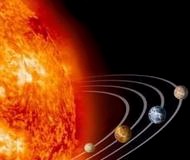
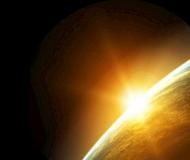


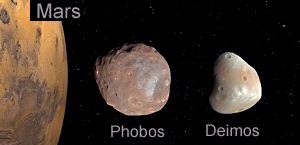


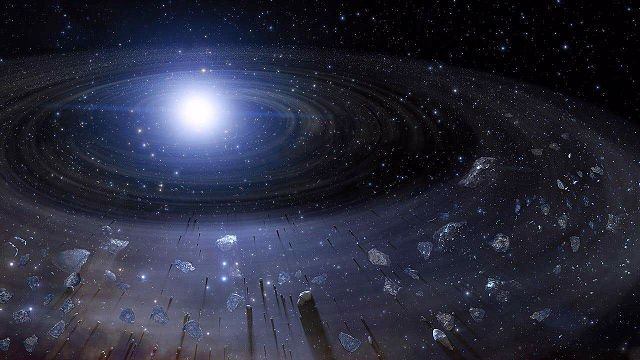


 The surface of Mars now is full of rocks. The surface of Earth 200 mya was just like Mars.
These rocks have fallen from the sky on Earth, and then buried. Some were
exposed by wind or water. The exposed rocks are called
The surface of Mars now is full of rocks. The surface of Earth 200 mya was just like Mars.
These rocks have fallen from the sky on Earth, and then buried. Some were
exposed by wind or water. The exposed rocks are called 
